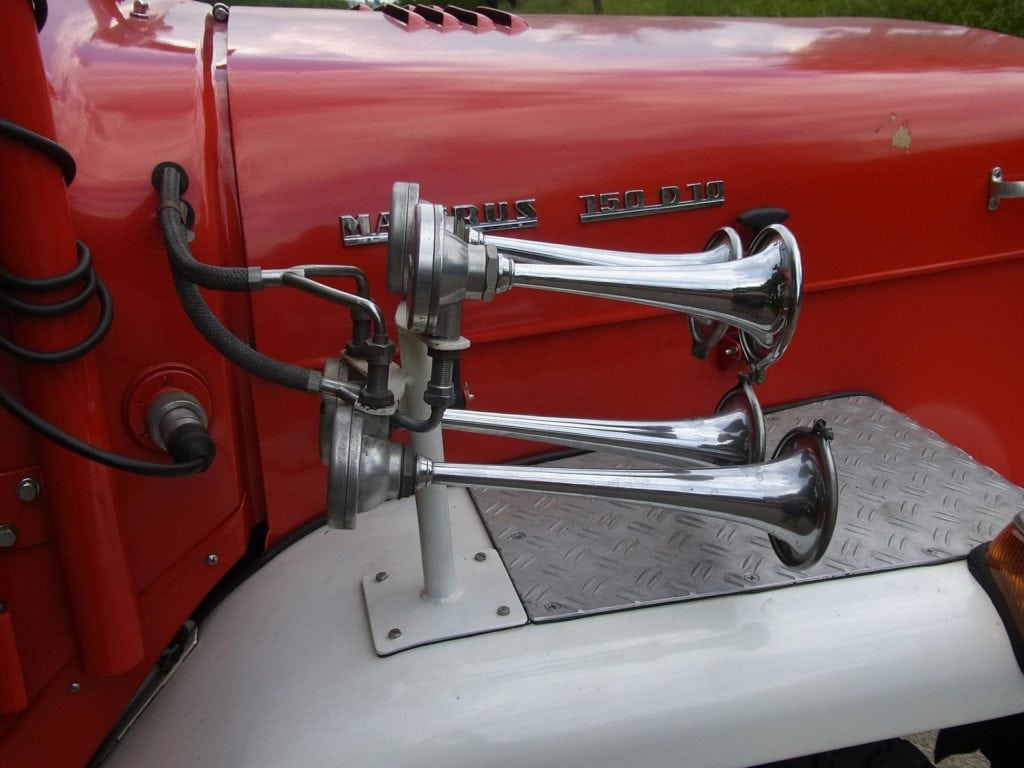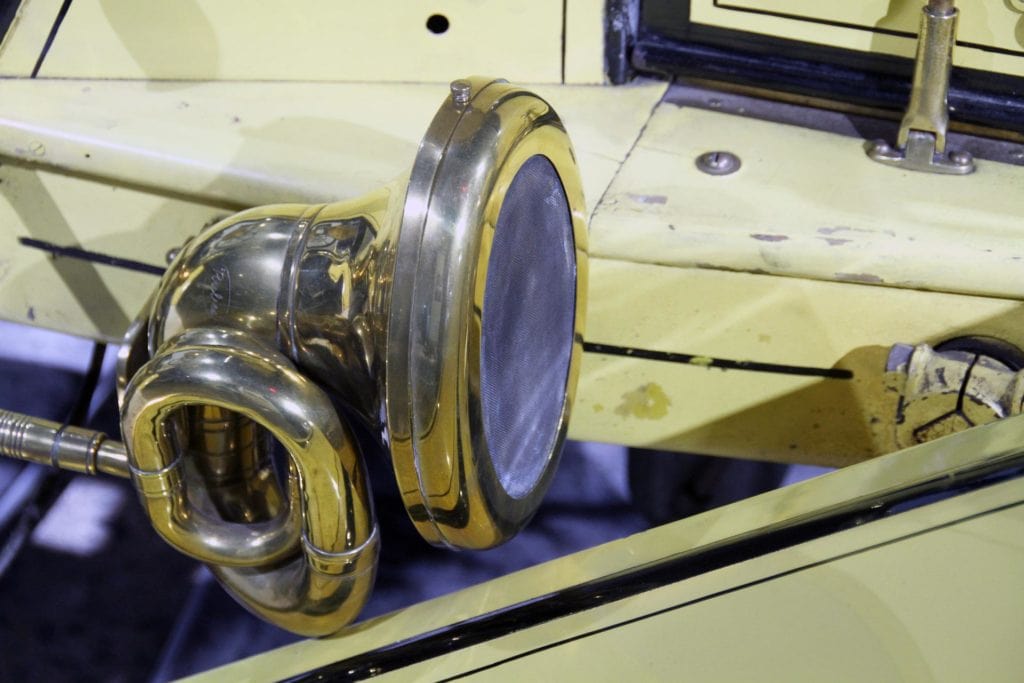How Do Car Horns Work? (Types & Mechanics Explained)
-
Pete Ortiz
- Last updated:

The horn is a simple sound-producing device that helps various drivers communicate with one another or with pedestrians on the road. Without it, drivers wouldn’t be able to signal their actions or even alert pedestrians of an impending collision.
As a driver, you’re legally obligated to ensure that your vehicle’s horn is always in good working condition. You frequently have to test it, to be certain that the sound generated is loud enough to be heard at a distance of at least 200 feet.
Back in the day, the horn used to be a trumpet that featured a rubber air bladder. Gently squeezing the bladder would generate an audible sound that would warn or signal other road users. We’ve come a long way since then though, as you’ll learn when we look at the different types of horns.
 How Does it Work?
How Does it Work?
It’s important to note that current iterations of car horns are more complex in design compared to the old models. Thanks to electromagnetism, we’ve been able to manufacture horns that are not only louder but also more efficient.
In a broken-down form, you’ll realize that the horn is essentially a system in itself. And the cogs that are part of this system include:
- An electromagnetic coil
- A switch
- A casing (serves the purpose of a megaphone)
- A flexible metal diaphragm
The spring steel is what makes the diaphragm flexible. When it’s subjected to a certain degree of force, it seamlessly moves back and forth.
Besides the spring steel, the diaphragm also features a solenoid. In some circles, the solenoid is called an electromagnet. Once it’s been energized, it automatically applies its magnetic force on the spring, making it flex concentrically.
The flexing is actually the thing that initiates the generation of the sound produced, while simultaneously de-energizing the solenoid. And that whole cycle gets repeated again and again, any time the driver presses the horn button.

What Are the Different Types of Horns?
Bulb Horns
They are called “bulb horns” because the rubber featured in the design sort of resembles a bulb. But just like the old models, these horns are tubular with openings that are conical in shape. To generate sound, the air has to come out of the opening. And for that to happen, the driver has to squeeze the horn.
The bulb horn concept can be explained by the principle of the reflection of sound. These models were previously reserved for bicycles, but nowadays we see them installed in buses and trucks.
Air Pressure Horns
As you might have guessed, this variant fully relies on air pressure. When the driver presses the button, the air gets compressed inside the device before being let out in a reed. Needless to say, the release is what actually generates sound.
This particular iteration is a common installation in automobiles that contain air tanks, as it requires an air-pressure braking system to be effective. Without adequate air, the sound generated won’t be audible.
Electric Car Horns
These models rely on the principle of electromagnetism to generate sound. And they are usually categorized into two groups because the sounds are produced in different ways. Your vehicle will either have an electric horn or a wind tone.
If the horn is a wind tone, just know that the honk or beep will directly emerge from the diaphragm, before being relayed to the windpipe. But if it’s electric, a coil will be magnetized to compel the diaphragm to vibrate so that the pressure generated in the process can produce a sound.
Given an option, we’d encourage you to go with the electric horn. While both of them are audible, the electric variant offers more resistance to wear and has a relatively long lifespan.
Klaxon
The Klaxon is not your typical type of horn. It looks like an ordinary horn but sounds very different. Instead of “honking” or “beeping”, the sound produced will either be an “ahooga” or “kalooga”.
We don’t know if those sounds have meanings in the Greek community, seeing as “Klaxon” was derived from “klaz—that’s a Greek word that loosely translates to “I shriek”.
Where Are Car Horns Used?
The prime function of the automotive horn hasn’t changed over the years. The only change that we’ve noted is how less dependent they’ve grown on electrical power and magnetic interference.
Drivers rely on horns to send early warning signals to other drivers or pedestrians. Many accidents occur when road users are unaware that motorists are approaching from opposite or separate directions. The role of the horn is to help us avoid such accidents.
Horns are also regarded as communication tools. You’re allowed to “beep” or “honk” just to let the driver of the car that’s in front of you know that the traffic lights have already changed, for example. Their response might be slow because they are busy texting, calling, or conversing with a fellow passenger.
- Used in traffic to alert drivers
- Reduces road accidents
- Can be used to call attention to certain hazards
- Used in break-in situations to call for help
- Contributes to noise pollution
- Can be misused by high-anger drivers
- May distract other drivers
Frequently Asked Questions (FAQs)
What Determines a Horn’s Note?
The frequencies and notes of the sounds produced by the different types of horns are infinite in number. And those changes can be attributed to the versatility of the diaphragm. Its casing, mechanical design, shape, physical size, and a whole bunch of other parameters, often influences the type of note generated.

How Do You Test the Functionality of a Horn?
If your vehicle’s horn is malfunctioning, there’s probably a loose connection somewhere, or it needs to be replaced. But to be sure you’ll have to directly connect it to the car’s battery. If there’s a sound generated, find the loose connection and fix it. If nothing’s happening, replace it with a new one.
How Loud Is a Car Horn?
On a logarithmic scale, the intensity of the sound produced by a car horn is 110 decibels. To put it into context, that’s the same level of noise as the one you’d experience at a nightclub, meaning it can easily damage your hearing. According to experts, noise levels that are above 110 decibels can permanently damage your ears.
Conclusion
Gone are the days when someone would wave a red flag while blowing a horn to alert pedestrians and animals of a fast-approaching vehicle. The automobile industry has evolved to the point where we now have different horn types serving different industries. It’s of vital importance that you remember to upgrade your car horn anytime you get the chance to avoid accidents and miscommunication while using the road.
Featured Image Credit: Pixabay
Contents

 How Does it Work?
How Does it Work?